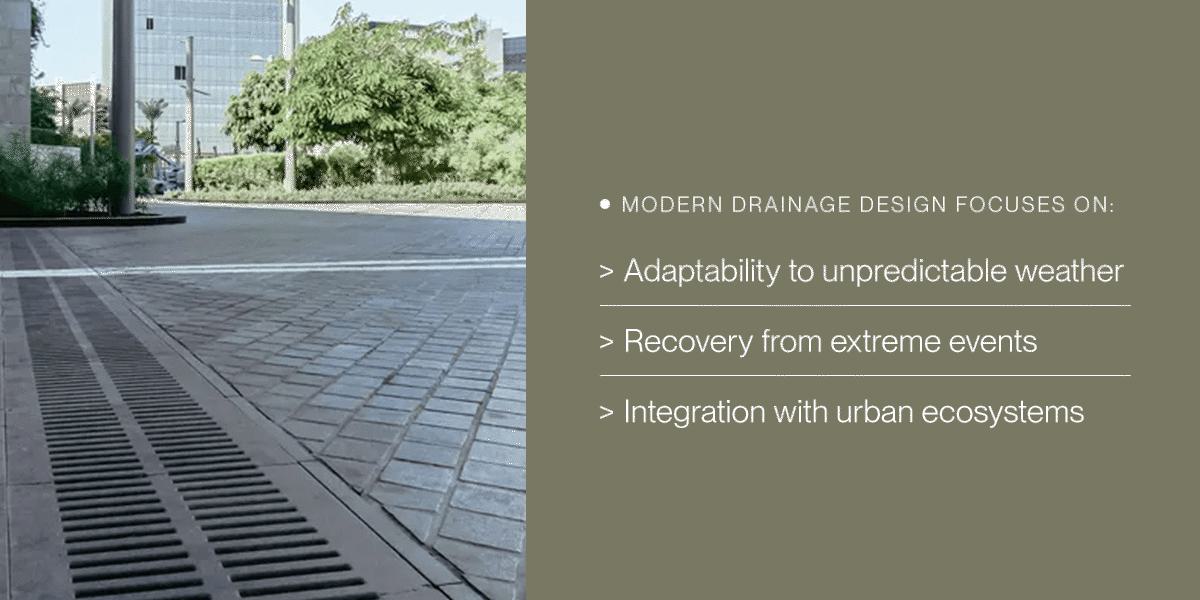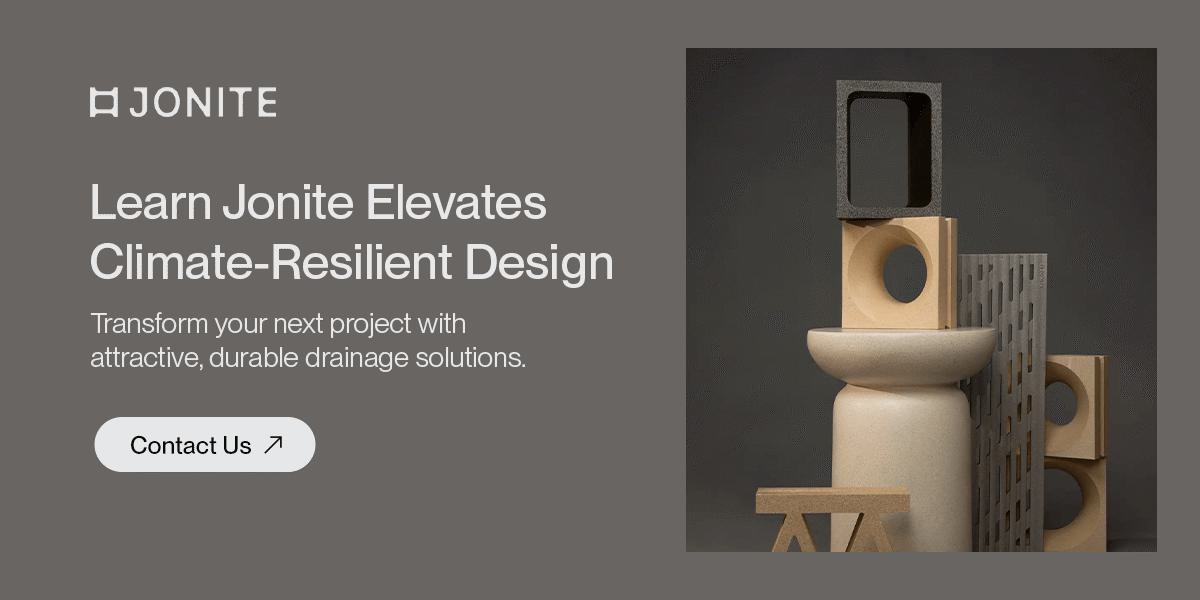Urban environments face unprecedented water management challenges as climate change accelerates. Drainage systems initially built to handle predictable, moderate weather patterns are now subject to more frequent and severe storms, flash floods and prolonged droughts. The imperative for architects and landscape architects is straightforward — design beautiful, functional and resilient urban spaces. Fortunately, innovative, design-forward solutions can future-proof your projects.
The New Reality of Urban Water Management
A perfect storm has hit urban water drainage. Rainfall frequency, duration and intensity have increased dramatically as more people move to cities. The scientific community's consensus is that extreme rainfall will intensify globally and regionally as about 68% of the global population lives in urban areas by 2050, putting water management at a crossroads.
Systems built for the past century's weather patterns are increasingly inadequate, leaving cities vulnerable to flooding and water scarcity. Accepting the realities of climate change will push developers toward solutions that can withstand and adapt to these pressures.
The “new normal” includes:
- More intense and frequent rainfall events
- Flash flooding in urban centers
- A 2% to 36% increase in water pollutants resulting from overwhelmed stormwater systems
- Extended droughts that stress water reserves
The core challenge facing professionals working in the built environment is finding the best drainage solutions for flood-prone cities while also considering long-term water conservation and reuse.
How Climate Change Affects Urban Drainage Systems
Two significant impacts — overburdened infrastructure and the urban heat island effect — drive the need for more climate-resilient drainage solutions.
Overburdened Gray Infrastructure
Conventional pipes and sewer systems are increasingly unable to handle the volume and intensity of today’s storms. As a result, cities see more frequent sewer backups into streets and buildings, alongside widespread urban flooding that causes property damage and poses public health risks. These challenges illustrate the limitations of traditional “gray” infrastructure and underscore the urgent need for innovative, adaptive approaches to urban flooding prevention.
The Urban Heat Island Effect
Hard, nonporous surfaces like concrete and asphalt absorb and radiate heat, which raises local temperatures. This urban heat island effect can intensify storm patterns, resulting in sudden, heavy downpours. The increased volume and speed of surface runoff from these storms put even more pressure on existing drainage systems, highlighting the urgency of addressing climate change impacts in cities.
Shifting Toward Climate-Resilient Drainage Design
Forward-thinking professionals embracing the future of architecture and construction are moving beyond traditional stormwater disposal. The new paradigm is climate-resilient drainage systems designed to adapt, recover and even thrive under changing conditions.
Modern drainage design focuses on:
- Adaptability to unpredictable weather
- Recovery from extreme events
- Integration with urban ecosystems
The goal of modern urban drainage design is to treat stormwater as a valuable resource instead of viewing it solely as waste to remove. By mimicking natural water cycles, cities can slow down, store and filter runoff within the urban landscape. This approach reduces flooding and erosion, supports groundwater recharge and improves water quality.
Embracing resilient drainage solutions enables architects and landscape architects to design sustainable urban environments that can withstand the challenges of a changing climate.

Exploring Sustainable Urban Drainage Systems
Sustainable urban drainage systems, or SuDS, are at the forefront of climate-adaptive design. SuDS manage rainfall where it falls, using natural processes to slow, store and treat water at or near the surface instead of channeling it away. Features like permeable paving, green roofs, swales and ponds reduce flooding and improve water quality.
Engineers can integrate SuDS into a range of settings, making communities greener and more appealing. When planted with trees and other vegetation, they:
- Support biodiversity
- Improve air quality
- Reduce urban heat
- Boost citizens' well-being
- Filter and treat runoff
These systems provide architects and landscape architects with a toolkit for managing water sustainably, without compromising aesthetics or usability.
Permeable Pavements and Surfaces
Permeable pavements and surfaces let rainwater soak into the ground instead of pooling, which reduces runoff and replenishes groundwater supplies. These materials naturally filter out pollutants as water passes through, preventing contaminants from entering the ecosystem.
Sustainable drainage systems are especially well-suited for areas where function and appearance are crucial, such as:
- Plazas
- Walkways
- Parking areas
- Highways
- Public open spaces
By integrating permeable surfaces into urban designs, architects and landscape architects can effectively manage stormwater while maintaining the visual appeal of public spaces.
Bioswales and Rain Gardens
Bioswales and rain gardens are landscape features designed to collect, channel and treat stormwater runoff. By slowing and filtering water, they manage excess rainfall while improving water quality. These solutions also create appealing green spaces within urban environments. Their flexible design is easy to incorporate into various settings, from streetscapes and parking lots to residential yards and public parks.
In addition to their functional role, bioswales and rain gardens support local biodiversity by providing habitat for plants and pollinators. They also improve public and private spaces, making outdoor areas more inviting and environmentally friendly. These features contribute to healthier, more resilient urban landscapes by blending form and function.
Green and Blue Roofs
Green and blue roofs are innovative solutions for managing stormwater in urban environments. Green roofs grow a cover of vegetation that absorbs rainwater, reducing runoff and providing natural insulation for buildings. Blue roofs temporarily hold rainwater and release it gradually, preventing drainage systems from becoming overwhelmed during heavy storms.
Both options are outstanding in densely built cities with limited ground-level space. By using rooftops, they contribute to sustainable urban drainage and are among the best solutions for flood-prone cities.
Uniting Resilient Design With Lasting Aesthetics
The effectiveness of any advanced drainage system depends on the design of its components. For architects and landscape architects, quality materials can make the difference between a functional solution and an integrated, visually compelling design.
Jonite custom-reinforced stone grates meet the demands of modern, climate-resilient urban drainage systems. These well-engineered grates provide exceptional durability and load-bearing strength, making them suitable for high-traffic areas and challenging environments. They're also aesthetically versatile, allowing architects and landscape architects to match or enhance surrounding paving and surface materials for a cohesive look.
Jonite grates integrate seamlessly with SuDS for high-performance water management and creative design goals.
Learn Jonite Elevates Climate-Resilient Design
Transform your next project with attractive, durable drainage solutions. Browse our gallery of project applications to discover how to elevate your climate-resilient spaces or contact our team for expert guidance on integrating Jonite into your next urban design.





